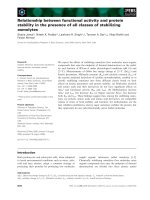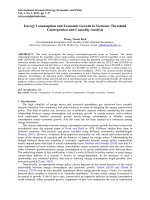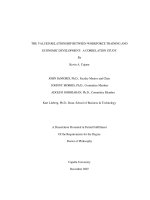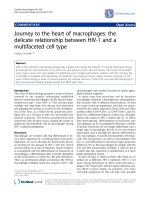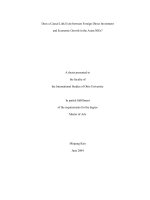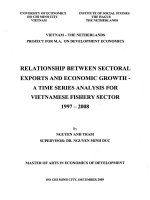The causal relationship between, electricity consumption and economic growth in Kingdom of Saudi Arabia: A dynamic causality test - TRƯỜNG CÁN BỘ QUẢN LÝ GIÁO DỤC THÀNH PHỐ HỒ CHÍ MINH
Bạn đang xem bản rút gọn của tài liệu. Xem và tải ngay bản đầy đủ của tài liệu tại đây (475.53 KB, 7 trang )
<span class='text_page_counter'>(1)</span><div class='page_container' data-page=1>
<b>International Journal of Energy Economics and </b>
<b>Policy</b>
ISSN: 2146-4553
available at http: www.econjournals.com
<b>International Journal of Energy Economics and Policy, 2021, 11(1), 333-340.</b>
<b>The Causal Relationship between, Electricity Consumption and </b>
<b>Economic Growth in Kingdom of Saudi Arabia: A Dynamic </b>
<b>Causality Test</b>
<b>Ibrahim Abdelrasoul Mohammed Belal</b>
<b>1</b><b><sub>*, Sumaya Awad Khader Ahmed</sub></b>
<b>2,3</b><b><sub>, Faouzi Hedi Boujedra</sub></b>
<b>1</b>1<sub>Department of Economics and Finance, College of Business Administration, University of Hail, Ha’il, Saudi Arabia, </sub>2<sub>Department of </sub>
Economics, Sudan Academy of Science, Sudan, 3<sub>Department of Business Administration, Al Jouf University, Saudi Arabia. </sub>
*Email:
<b>Received:</b> 20 July 2020 <b>Accepted:</b> 22 October 2020 <b>DOI:</b> />
<b>ABSTRACT</b>
The main objective of this study is to empirically test whether there exist short run and long run causality between, residential electricity consumption
(REC), industrial electricity consumption (IEC) and economic growth in Kingdom of Saudi Arabia (KSA). Time series data for this study spans from
1990 to 2019. The study adopts granger causality and co. Integration analysis to estimate a vector error correction model (VECM). Results from
error correction model show that there exist long run co. integration relationship between targeted variables. In addition, VECM results indicates
that, industrial electricity consumption is inelastic to the changes in electricity prices with respect to economic growth, while residential electricity
consumption shows elastic relationship. Granger causality test indicates there is unidirectional relationship, running from economic growth to industrial
electricity consumption, which lead to accept, proactive (conservative) hypothesis. In this case, energy conservative policy will have little or no effect
on economic growth. Nevertheless, results proof acceptance of neutrality hypothesis in the case of residential electricity consumption and economic
growth. The study therefore, recommends that in Saudi Arabia, policy makers should consider expanding their energy-mix alternatives, in order to
cope with the future industrial electricity demand arising from increased economic growth.
<b>Keywords:</b> Electricity Consumption, GDP Growth, Co-integration and Causality
<b>JEL Classifications:</b> O3, O4
<b>1. INTRODUCTION</b>
KSA is one of the largest exporter of petroleum and possess
about 18% of the world petroleum reserves, Saudi Arabia oil and
gas sector account for about 50% of the GDP, and about 85%
exports earning (Maghrebi et al., 2018). In late April 2016 KSA
vesion2030 announced, based on three main pillars, they are a
vibrant society, a thriving economy and an ambitious nation. A
key goal of the thriving economy build on themes of diversified
economy of less dependent on oil revenues, to achieve this goal
and others, Saudi Arabia authority announced a set of parallel
programs, which include the National Transformation Programs,
which providing more information about the implication of
energy sector (Fattouha and Amrita 2016). As one of the main
energy policy implications, at the end of December 2015, the
Saudi Arabian government raised some of its administered retail
energy prices. For example, the price of automotive diesel fuel
increased from 0.25 Saudi Arabian Riyal (SAR) per liter to 0.45
SAR, while the price of 95 gasoline increased from 0.60 SAR to
0.90 SAR increases of 80% and 50%, respectively (Platts, 2015).
In addition, the price of natural gas increased from $0.75/MMBtu
to $1.25/MMBtu, an increase of 67% (Platts, 2015). However, if
Saudi Arabia efforts to transitions towards a more diverse and
energy efficient-economy are unsuccessful, then social wale fare
</div>
<span class='text_page_counter'>(2)</span><div class='page_container' data-page=2>
will remain vulnerable to sowing in international oil markets,
increasing the risks of declining GDP growth over time. In KSA,
the retail prices of energy (oil products, natural gas, and electricity),
have traditionally been set by public authorities, resulting in the
retail prices being below the international market price (ECRA,
2015). Given the fact that, energy prices, more specifically oil price
has been historically, volatile and uncertain; inevitably it influences
KSA economy differently, at different point of time. Electricity
consumption in KSA has been a accompanied by large increase
in GDP growth. Indeed, EC in Saudi Arabia grow annually at a
rate of 12% and 25% during 1970s and 1980s, and by 6%, this
high level of EC is due to some main factors, such as growth of
industrial sector; electricity subsidies and modernization of cities
(Narayan and Smyth, 2009). The largest proportion of EC in KSA
is attributed to the residential sector account about 53% of total
EC, followed by industrial sector account about 18% (on average)
of total EC, this mean that residential sector derive EC rather
than industrial sector, which is the case in many developed and
developing countries. Nevertheless, many measures have taken
by KSA authority to reduce the adverse effects of climate changes
and global warning to achieve sustainable development. For
instance, acceptance of Kyoto protocol of climate changes (2005),
and launch of 2008 National Energy Program (NEP), which takes
about eight measures aimed to increase energy efficiency by 30%
up to 2030 (Mezghany and Haddad, 2016). The step that has
been taken by the Saudi Arabia government to the environment
by preserving energy resources have important implications for
the sustainable development of the country. Notwithstanding, any
effective energy policy should consider the dynamic nature of the
relationship between EC and GDP growth should have a long-term
vision (Sari and Soytas, 2009) and Micheal and Alegre (2009).
Therefore, in this paper we try to empirically analyzes the impact of
changes of electricity consumption on real GDP growth, during the
period between 2000 and 2019, to explain significances of energy
policy in short-run as well as in the long-run. In fact, the effect of
electricity consumption resulting from electricity tariff changes, is
differ from one country to another, depending on economic structure
of the country, historically, there is no exactly defined direction
and causality relationship between electricity consumption, and
economic growth. In literature there are four energy consumption
and GDP growth hypothesis namely, growth hypothesis; proactive
hypothesis; neutrality hypothesis and feedback hypothesis
(Syzdykova et al., 2020). Growth hypothesis indicates economic
growth is energy dependence; if there exist one-way causality from
energy consumption to economic growth in this case increasing
energy prices aiming at energy saving will adversely affect economic
growth. In the case of proactive (conservative) hypothesis, it is
one-way causality running from growth to energy consumption;
in this case, energy conservative policy will have little or no effect
on economic growth. On the other hand neutrality hypothesis,
exist when there is lack of causal relationship between energy
consumption and economic growth, finally feedback hypothesis
mean, there is two-way causal relationship between energy
consumption and economic growth which shows a complementary
effect between the two variable (Apergis and Payne, 2010). The
choice of Saudi Arabia for this study motivated by the fact that Saudi
Arabia has experienced a sharp increase in energy consumption and
carbon emissions in recent years because of its strong economic
and industrial growth. Historically high international oil prices
and large domestic fuel subsidies also play an important role in
the recent economic growth and high-energy consumption in the
country. This study aims to test empirically the causality between
energy consumption represented by electricity consumption for both
residential and industrial sectors, and real GDP growth in KSA.
The principal hypothesis of this study based on various literatures
and other related studies; such that, there exist bidirectional growth
hypothesis, running from electricity consumption of both sectors to
GDP growth in KSA. Using time series data for the period extended
from 1990 to 2019, in the second part theoretical background
presented about the historical development of theories of economic
growth, third part, summarizes previous studies on the relationship
of electricity consumption, and economic growth. The fourth part
explain the methodology and the sources of data. In the fifth part,
empirical analysis and results discussed, finally main concluding
points and recommendations presented.
<b>2. OVERVIEW OF ELECTRICITY SECTOR </b>
<b>IN SAUDI ARABIA</b>
Despite stable and favorable macroeconomic indicators in the
past years, the Saudi economy faces many challenges. The main
concerns are related to its demographic dynamics leading to
an urgent need to generate enough employment for its young
population and addressing the issue of its energy system
sustainability (Said and Marie 2015). The KSA government has
prioritized sustainable measures as gateway to better future. As
mentioned earlier, the Saudi 2030 Vision was implemented in April
2016; in this respect, the government has taken serious steps to
change the country’s economy, from oil-based economy to
multi-sources economy. Therefor Saudi government introduced many
programs and other efficiency measures. For instance in 2017
the International Energy (IEA) stated that, KSA was targeting
120 gigawatt electricity generating capacity by the of 2032 to
accommodate the country growing electricity demand, in 2018
the government increase investment fund to increase electricity
generation to about 200 gigawatt by the end of 2030 (Institute for
Energy Economics and Financial Analysis, 2018).
In the context of hot-arid climates, KSA was ranked among
the top 10 countries of the highest electricity consumption,
nevertheless electricity generation consume nearly one-third
of daily oil production in KSA (Alshibani and Alshamrani,
2017). Notwithstanding, annual electricity usage growing by
approximately 6-8%, according Saudi Electricity Company
(SEC) residential and industrial sectors consuming about 71%
of electricity power, commercial consumption 12%, government
consumption 11% and about 2% of electricity consumed by
agricultural sector (M.O.W.A. Electricity, 2014). Climate is
the major factor as 70% of electricity sold attributed to air
</div>
<span class='text_page_counter'>(3)</span><div class='page_container' data-page=3>
sources would result of a net loss of about more than 3 million
barrels of oil per day, or so cold “burning oil to get cool” (Lahn and
Stevens, 2008). The sectoral distribution of electricity consumption
presented in the following Figure 1.
To sum up, it is essential to make plans to promote alternative
energy sources. Nonetheless, knowing the causes of high-energy
consumption is critical to ensure holistic, sustainable future
development. The KSA government implemented several action
to avoid future economic crisis as a consequences of high-energy
consumption, which include implementing of new Saudi Building
Code (SBC) and activate Saudi Energy Efficiency Center (SEEC)
and plans for renewable energy sources. Notably the decision
to stop subsidizing the electricity has led to growth in energy
efficiency uses and awareness (Apicorp Energy Res, 2018). The
focus of this study is to test empirically the cases of rabid increases
of electricity consumption, with reference to different measures,
which has been taken by KSA government to sustain electricity
generation and distribution. Notwithstanding, various model has
been utilized to explain electricity-growth relationship, this study
rely on emerging model to explain causal relationship, between
residential electricity consumption (RECTt), industrial electricity
consumption (IECt) and GDP growth in KSA, to evaluate the
significances of energy policy in short-run as well as in the long-run.
<b>3. LITERATURE REVIEW</b>
Number of past studies examine the relationship between electricity
consumption and GDP growth causal relationship, some of these
studies focused on group of countries, while other study individual
countries Sheilla et al. (2016), Dossou, (2019), Hasan et al., (2017),
Njindan (2014) and Nyasha et al., (2016). The fact that electricity
consumption represent the highest percentage of energy consumption
in most countries has shifted debates to what our study examine.
The first group concludes that electricity consumption causes
economic growth (electricity led growth thesis); the second group
concludes that economic growth causes electricity consumption
(the growth-driven electricity consumption thesis). The third group
concludes that there is bidirectional causality between electricity
consumption and economic growth (the feedback thesis); finally, the
fourth group argues that there is no causal link between electricity
consumption and economic growth (the neutrality thesis) Bernard
(2016). The electricity led growth studies has been confirmed by
studies such as, Masih and Msih (1996) for India, Lee (2005) for
15 developing countries, Ho and Siu (2007) for Hong Kong. The
growth-driven hypothesis paper has been confirmed by studies
such as, Kraft and Kraft (1978) for USA, Al-Iriani (2006) for the
gulf co-operation countries and Rufael (2006) UNISA (2016) and
Odularu (2008) for the case of Cameron, Ghana and Nigeria. In
addition, feedback hypothesis was identified by various studies
such as, Asafu-Adjaye (200) for Thailand and Philippines, Soytas
and Sari (2003) for Argentina and Odhiambo (2009) for the case
of Tanzania and South Africa. Others studies found no causal link
between electricity consumption and GDP growth such as, Erol and
Chu (1987), and Yu and Jin (1992) for the case of the USA; Murray
and Nan (1996) for France; Germany, India, Israel, Luxembourg,
Norway, Portugal, UK, USA and Zambia and Akinlo (2008) for
Cameron, Cote d`Ivoire and Kenya. Some other studies examine
the causal relation between energy consumption as a whole and
GDP growth. Such as Athanasois et al. (2020) and Amany (2010)
study revisiting the impact of energy prices on economic growth;
lesson learned from the European Union, they concluded that, for
residential electricity sector shows highest level of influence on
real GDP, while industrial electricity sector and crude oil price
“Granger Cause” residential electricity prices. Gonand et al.
(2018<i>)</i>, investigates the intergenerational welfare impact of raising
administered retail energy prices in Saudi Arabia, they developed
first model of overlapping generation (called MEGIR-SA), it is
shown that the additional oil income associated with the increase
in domestic energy prices tends to be relatively more beneficial
to future generations if it is recycled through public investment.
Athanasios et al. (2020), study revisiting the impact of energy
prices on economic growth; lesson learned from the European
Union; they concluded that, for residential electricity sector shows
highest level of influence on real GDP, while industrial electricity
sector and crude oil price “Granger Cause” residential electricity
prices. The following Table 1 summarizes some empirical studies
examining causal relationship between electricity consumption and
economic growth.
Most of the previous studies focused on the causal relationship
between electricity consumption and economic growth, while our
study disaggregates electricity consumption in to residential and
industrial sectors to test for short run and long run relationship
between the targeted variables. Mostly important here is policy
implications of impact of causality results between the target
variables; if growth hypothesis is achieved, it indicates that economic
growth is energy dependency, in this case economic policy aimed at
raising energy prices to reduce energy consumption or energy saving
would adversely affect economic growth. A bidirectional relation
between energy consumption and economic growth (feedback)
reflect interdependence and complementary effects between
energy consumption, and economic growth. In the case of neutral
hypothesis energy saving policies may has little or no effect of energy
consumption changes on economic growth Syzdykova et al. (2020).
<b>4. DATA AND METHODOLOGY</b>
The study adopt causality and co-integration analysis to
empirically estimates the short run and long run effects of
<b>Figure 1:</b> Distribution of electricity consumption by sector
</div>
<span class='text_page_counter'>(4)</span><div class='page_container' data-page=4>
electricity consumption(residential and industrial sectors) on
real GDP growth in KSA. The study time spams from
1990-2019, time series data includes real GDP growth, residential and
industrial electricity consumptions will be obtain by consulting
different sources. Real GDP growth data obtained from World
Band database, and electricity consumption (MWh) received from
Saudi Arabian Monetary Authority (SAMA) statistics.to test the
main study hypothesis.
H<sub>1</sub>: There is bidirectional growth hypothesis running from industrial
electricity consumption (IECt) and residential electricity (RECt)
consumption to GDP growth in KSA, during the study period
extended from 1990 to 2019 (Bekun et al., 2019). Alternatively,
H<sub>2</sub>: There is unidirectional hypothesis running from industrial
electricity consumption (IECt) and residential electricity(RECt)
consumption to GDP growth in KSA, during the study period
extended from 1990 to 2019 (Shabestari, 2018). For the purpose
of data analysis, we specify the following steps:
<b>4.1. Unit Root Test</b>
Unit root test, allow specifying the order of integration, as many
econometrics data shows, non-stationary behavior, therefore
a series of ∆<i>Y = Y<sub>t</sub></i>–<i>Y<sub>t-1, </sub>is</i> often stationary. Then the order of
integrated series written as <i>I</i> (1) satisfies the first difference of
<i>Y<sub>t</sub></i>, We use the ADF test (Dickey and Fuller, 1981), (Dickey and
Fuller, 1996) to examine whether a series has a unit root. Consider
the ADF tests as follows:
1 <sub>1</sub> t
1
1
1
<i>p</i>
<i>t</i> <i><sub>i</sub></i>
<i>t</i> <i>Y</i> <i>t</i>
<i>Y</i> φ <sub>− +</sub> − β <i>Y</i> ε
= ∆ −
∆ =
∑
+ <sub> (1)</sub>0 1 <sub>1</sub> t
1
1 1
<i>t</i>
<i>p</i>
<i>t</i> <i><sub>i</sub></i>
<i>Y</i> α φ <i>Y</i><sub>−</sub> <sub>=</sub>−β ∆ −<i>Yt</i> ε
∆ =
∑
+ <sub> (2)</sub>0 1 1
1
1 1 1 t
<i>p</i>
<i>i</i>
<i>t</i> <i>t</i>
<i>Y</i> α α<sub>+</sub> <i>t</i> φ <i>Y</i><sub>−</sub> <sub>+</sub> <sub>=</sub>− β <i>Yt</i> ε
∆ = +
∑
∆ − + <sub> (3)</sub>From the above, system equations. It is clear that equation(1) did not
include either drift or trend, but the drift term <i>α<sub>0 </sub></i>added to equation
(2) and both <i>α<sub>0 </sub></i>and deterministic trend <i>α<sub>1 </sub></i>t added to equation (3). If
augmenting lag (p) known, augmented test is identical to the simple
augmented Dicky-Fuller test, otherwise, lag dropped until the last
lag is statistically significant. Based on ADF test the following
hypothesis tested to obtain stationary of the variables.
H<sub>0</sub>: <i>ϕ </i>-1<i>=</i> 0 or H<sub>1</sub>: <i>ϕ</i> -1˂0 (4)
H<sub>0</sub> mean that the variable not stationary
H<sub>1</sub> mean the variable stationary or has no unit root.
<b>4.2. Johansen Co-integration Test</b>
To estimate short-run and long-run dynamic impact, of electricity
consumption on GDP growth, Johansen and Juselus (1990)
co-integration test will employ, after determining the optimal lag
length (P) for the model. Two-time series data for variables X<sub>t </sub>and
Y<sub>t, co</sub>-integrated, if they have the same order of co-integration and
there exist a linear combination of these series. In this paper, we
apply Johansen Maximum Likelihood method (1991), to obtain
the number of co-integration equations.
<b>4.3. Estimation of Vector Error Correction Model </b>
To estimate VECM, based on the previous co. Integration test, in order
to examine the impact of explanatory variables on GDP growth in
KSA. The model presented in the following reduced form equations:
LnGDPt = b<sub>0</sub>+b<sub>1 </sub>lnREC<sub>t</sub>+b<sub>2 </sub>lnIEC<sub>t</sub>+Ut (5)
Where: U is the disequilibrium error, t: Time series (1990-2019),
GDP: Is real GDP growth rate, residential electricity consumption
(REC<sub>t</sub>), and industrial electricity consumption (IEC<sub>t</sub>) in the short
run. Assuming there is only one co-integrated relationship among
the examined variables, and then equation (5) as multivariate
model used to obtain the following equation.
U<sub>t</sub> = lnGDP<sub>t–</sub>b<sub>0</sub>–b<sub>1 </sub>lnREC<sub>t</sub>–b<sub>2 </sub>lnIEC<sub>t</sub> (6)
Where: U<sub>t </sub>is the disequilibrium error, shows the range of changes
in real GDP, residential electricity consumption (REC<sub>t</sub>), and
industrial electricity consumption (IEC<sub>t</sub>) in the short run. If the
variables are stationary at first difference <i>I </i>(1), and U<sub>t </sub>is stationary,
it mean there exist a linear combination among the variables. If
<b>Table 1: Summary of empirical studies</b>
<b>Author</b> <b>Period</b> <b>Country</b> <b>Method</b> <b>Result</b>
Kraft and Kraft (1978) 1947-1974 USA Granger causality EG→EC
Asafu-Adjaye (2000) 1973-1995 India, Indonesia Co-integration, ECM EC→EG
Alshehry and Belloumi (2015) 1971-2010 KSA Johansen Co-integration EG↔EC
Long et al. (2015) 1952-2012 China Co-integration analysis EG↔EC
Shahbaz et al. (2016) 1970-2012 Australia VECM EG↔EC
Jebli and Yousef (2017) 1980-2011 Tunisia VECM EG ↔EC
Riti et al. (2017) 1970-2015 China ARDL-VECM EG ←EC
Shabestari (2018) 1970-2016 Sweden ARDL-VECM EG↔EC
Bekun et al. (2019) 1960-2016 South Africa Pesaran et al., 2001 EG←EC
Iyke, 2015 1971-2011 Nigeria VECM EC→EG
Saleheen Khan et al., 2018 1991-2014 Kazakhstan ADRL and VECM EC→EG
Kumari and Sharma, 2016 1974-2014 India Co. integration and Granger causality EG→EC
Anon, 2016 1972-2011 Lesotho ADRL EG→EC
Aslan, 12 Aug 2013 1978-2008 Turkey ADRL EG↔EC
Sekantsi and Okot, 2016 1981-2013 Uganda ADRL and Granger Causality EG↔EC
</div>
<span class='text_page_counter'>(5)</span><div class='page_container' data-page=5>
the variables are stationary at first difference <i>I</i> (1), then we can
run the following VECM.
∆GDP<sub>t </sub>= <i>α</i><sub>1</sub> z<sub>t-1</sub>+lagged (∆GDP<sub>t, </sub>∆REC<sub>t,</sub> ∆IEC<sub>t </sub>)+є<sub>1t</sub> (7)
∆IEC<sub>t</sub> = <i>α</i><sub>2</sub> z<sub>t-1</sub>+lagged (∆GDP<sub>t, </sub>∆REC<sub>t</sub>, ∆IEC<sub>t</sub>)+є<sub>2t</sub> (8)
∆REC<sub>t</sub> = <i>α</i><sub>3</sub> z<sub>t-1</sub>+lagged (∆GDP<sub>t, </sub>∆REC<sub>t</sub>, ∆IEC<sub>t</sub>)+є<sub>3t</sub> (9)
Were, z<sub>t-1 </sub>is the error correction term, obtained from the result
of estimation of co-integration relationship, and є is error term
stationary at |<i>α</i><sub>1</sub>|+|<i>α</i><sub>2</sub>|+|<i>α</i><sub>3</sub>|≠0.
Recent developments of the co-integration concept indicate that
a vector autoregressive (VAR) model specified in differences is
valid only if, the variables under study are not co-integrated. If they
are co-integrated, an error correction model (VECM) should be
estimated rather than a VAR (Granger, 1988). Hendry and Juselius
(2000) emphasize the importance of correct model specification.
Following Granger (1988), we use a VECM instead of a VAR
model, since the VAR model is miss- specified in the presence of
co-integration. In addition, VAR models may suggest a short run
relationship between the variables, because long run information
removed in the first differencing, while a VECM can avoid such
shortcomings. In addition, the VECM can distinguish between a
long run and a short run relationship among the variables and can
identify sources of causation that cannot detected by the usual
Granger causality test (Suharsono et al., 2017).
<b>5. EMPIRICAL RESULTS</b>
<b>5.1. Unit Roots Test</b>
In time series analysis, financial and economic data is commonly
associated with trending behavior or non-stationary, to determine
whether a time series data are stationary or not, an important task to
avoid the spurious of estimated model and inaccurate forecasting.
For the purpose of this study, it is necessary to test for stationary
before running the co. Integration analysis. We use the ADF test
(Dickey and Fuller, 1981), to examine whether a series has a
unit root. Equation (3) employed to test previously mentioned
hypothesis of equation (4). Results of test stationary at level and
1st <sub>difference, for GDPt growth, RECt and IECt variables obtained </sub>
and summarized in the following Table 2.
Results in Table 2, unit root tests at the level, show that the values
of ADF is less than the critical value at 5% level of significant.
This mean that we cannot reject the null hypothesis that the series
of GDPt growth, RECt and IECt were not stationary. But when
the variable converted to 1st<sub> difference, the absolute values of </sub>
ADF is more than the absolute values of critical values at 5%
level of significant for all the three variables, therefore we accept
the alternative hypothesis, meaning that GDPt; RECt and IECt
variables are stationary in the 1st<sub> differences. This result is in line </sub>
with most of resent studies that, most of macroeconomic series
are non-stationary at the levels, only became stationary after taken
the first differences (Nelson and Plosser, 1982).
<b>5.2. Johansen Co-integration Test</b>
In order to run Johansen co. Integration test to determine whether
the variables has short run and long run causal relationship,
the model must satisfies some of basic requirements, firstly the
series must stationary at first difference not in the level, in the
above discussion, unit root test indicates that all three variables
are stationary at first difference. Secondly, perform Johansen co.
Integration optimal lag length (P) for the model, shown by VAR
lag order selection criteria result presented in the following table.
Referring to results in Table 3, we chose AIC optimal lag, in this
case, the lag selected by this criteria is equal two, then we can
proceed to run the co. Integration model to determine whether
our three variables GDPt growth, IECt and RECt has long run
relationship or in the long run they move together. Then, we
apply Johansen Maximum Likelihood method (1991), to obtain
the number of co-integration equations and the analysis results
shown the following table.
Table 4 present unrestricted co. integration rank test, it become
clear we rejected the hypothesis of having non-co. integration
equation, since Trace test indicates 1 co. integration equation
at 5% level, the estimated eigenvalue ratios and trace statistic
also indicate at most there is one co. integration equation in this
model. We can conclude that there exist long run co. integration
relationship between the series and the model that we are going
to estimate is not spurious.
<b>5.3. Estimation of Vector Error Correction Model </b>
<b>(VECM)</b>
To identify short run and long run causal relationship between
the study variables, in order to determine the responsiveness of
one variable to each other’s. VECM estimated based on the test
statistics presented in Table 4. Before running the basic VECM
model, we run some of co. efficient diagenetic test to insure if the
model has some statistical errors or not. Chi-square is significant
there for we reject existence of serial correlation, while
Jarque-Bera probability indicate the series under study are normally
distributed. In addition R2 <sub>= 60%, meaning that the model has good </sub>
fit, and P (F.stat. = 0.007) the overall model is suitable to explain
the long run causality between targeted variables. Estimates of
basic model for the targeted variables presented in the following
table.
<b>Table 2: Unit root tests</b>
<b>Variable</b> <b>Level</b> <b>1s difference </b>
<b>t.stat.</b> <b>ADF</b> <b>Prob*<sub>.</sub></b> <b><sub>Result</sub></b> <b><sub>t.stat.</sub></b> <b><sub>ADF</sub></b> <b><sub>Prob</sub>*<sub>.</sub></b> <b><sub>Result</sub></b>
GDPt –2.9677 0.933199 0.9945 Non-stationary –2.9718 4.498624 0.0014 Stationary
RECt –3.6891 0.985709 0.7443 Non-stationary –2.9718 4.923212 0.0005 Stationary
IECt –2.9677 0.152657 0.9340 Non-stationary –2.9718 9.214431 0.0000 Stationary
</div>
<span class='text_page_counter'>(6)</span><div class='page_container' data-page=6>
Result in Table 5, shows one co. integration econometric model
of VECM estimates, the results indicate that, there exist long
run causality running from IECt and RECt to GDPt growth ,
since the error correction term or speed of adjustment C(1) is
negative and statistically significant. This result consistent with
various studies that energy consumption-driven growth (Stern
and Enflo, 2013). IECt is negatively affect GDPt growth in
the long run, provide that 1% decreases in IECt lead to about
3.9% increases in GDPt growth at 5% level of significant. Thus
industrial electricity consumption in KSA is inelastic to the
changes in electricity prices with respect to GDPt growth. In
other words, even if industrial electricity prices raised, industrial
electricity consumption did not response to changes because in
the long run, industrial sector can absorb these increases, and
can Levey the burden to the consumers. Therefore, electricity
conservation policy in KSA must implement with some caution,
although the result in this analysis indicate that, electricity tariffs
did not pose any risks to GDP growth. This will held true, only
when Granger causality proof economic growth causes industrial
electricity consumption. With respect to residential electricity
consumption, result in Table 5 indicate that, there exist positive
effect on GDP growth providing 1% increase in RECt will
increase GDP growth by about 6% at 5$ level of significant,
this mean that raising electricity tariffs in the residential sector,
will decreases RECt ,consequently will result in adverse effect
on GDP growth.
To chick for short run dynamic, Wald Test employed. Results in
Table 6 indicate, Chi-square probability of null hypothesis C(4) =
C(5) = 0 is insignificant at 5% level , which mean there is no short
run causality running from IECt to GDPt growth, also the null
hypothesis C(6) = C(7) = 0 shows no short run causality running
from RECt to GDPt growth in KSA.
<b>5.4. Granger Causality Test</b>
According to Granger theory, if variables are co. integrated there
must be at least one direction of causality between the variables
to sustain the long run equilibrium relationship. Notwithstanding,
Engle-Granger, 1987, stated that in present of co. integration, there
exist always a corresponding error-correction representation. The
present of co. integration vector in the electricity
consumption-GDP growth model in KSA, shows that the variables included
in the model of this study are co. integrated and possess long
run relationship. VECM plays an important role in detecting the
indigeneity and exogenity of the variables, and direction and
causality effects between these variables. Since, not captured in
the co. integration model (Masih et al., 2009). Table 7 summarized
results of Granger Causality test based on VECM model as follows:
Results in Table 7 indicates there is unidirectional relationship
between industrial electricity consumption (IECt) and GDP
growth, since the relevant test reject the null hypothesis. This
<b>Table 3: Lag order selection criteria</b>
<b>Endogenous variables: GDPGT RECT IECT</b>
<b>Lag</b> <b>LogL</b> <b>LR</b> <b>FPE</b> <b>AIC</b> <b>SC</b> <b>HQ</b>
0 -1029.404 NA 6.20e+30 79.41569 79.56085 79.45749
1 -957.6856 121.3694* 5.02e+28 74.59120 75.17186* 74.75841*
2 -947.6492 14.66860 4.79e+28* 74.51148* 75.52763 74.80410
3 -942.7776 5.995816 7.16e+28 74.82905 76.28070 75.24707
4 -933.5094 9.268215 8.32e+28 74.80842 76.69556 75.35185
Source: Eviews9 software results.*Indicates lag order selected by the criterion
<b>Table 4: Unrestricted co. Integration rank test (trace)</b>
<b>Hypothesized Eigenvalue</b> <b>Trace</b> <b>0.05</b> <b>Prob.**</b>
<b>No. of CE(s)</b> <b>Statistic Critical value</b>
None* 0.585862 29.94355 29.79707 0.0481**
At most 1 0.202468 6.141513 15.49471 0.6788
At most 2 0.001229 0.033200 3.841466 0.8554
Source: Eviews9 software results. Trace test indicates 1 co. Integrating eqn(s) at the
0.05 level. *Denotes rejection of the hypothesis at the 0.05 level. **Denotes stationary
at 5% significant level
<b>Table 5: VECM estimates</b>
<b>Cointegrating Eq:</b> <b>CointEq1</b>
GDPGT(–1) 1.000000
IECT(–1) –3.96E-08
(4.3E-08)
[–0.92695]
RECT(–1) 6.06E-05
(0.00051)
[0.11943]
C –2.109404
<b>Coefficient</b> <b>Std. Error t-Statistic Prob. </b>
C(1) –1.106088 0.315674 –3.503897 0.0024
C(2) 0.138789 0.204744 0.677868 0.5060
C(3) 0.011452 0.176479 0.064889 0.9489
C(4) –9.98E-08 6.35E-08 –1.571044 0.1327
C(5) –9.67E-08 6.57E-08 –1.471080 0.1576
C(6) –0.000370 0.004128 –0.089534 0.9296
C(7) 0.004348 0.004072 1.067714 0.2990
C(8) -0.456559 1.351428 -0.337834 0.7392
Source: Eviews9 software results
<b>Table 6: Wald test: Null hypothesis: C (4)=C (5)=0</b>
<b>Normalized restriction (=0)</b> <b>Chi-square</b> <b>Probability</b>
C(4)=C(5)=0 3.031161 0.2197
C(6)=C(7)=0 1.143965 0.5644
Source: Eviews9 software results
<b>Table 7: Granger causality test results from VECM</b>
<b>Pairwise Granger causality tests</b>
<b>Lags: 1</b>
<b>Null hypothesis</b> <b>Obs F-Statistic</b> <b>Prob.</b>
IECT does not Granger cause GDPGT 29 0.00586 0.9396**
GDPGT does not Granger cause IECT 4.41644 0.0454**
RECT does not Granger cause
GDPGT 29 2.38337 0.1347*
</div>
<span class='text_page_counter'>(7)</span><div class='page_container' data-page=7>
results support proactive (conservative) hypothesis, it is one-way
causality running from growth to energy consumption, in this
case, energy conservative policy will have little or no effect on
economic growth. This finding implies that in KSA economic
growth derives industrial electricity consumption. This mean that
KSA is growth-dependence industrial electricity consumption, and
any indiscriminate energy-saving policy to promote economic
growth, may result in adverse effects on industrial sector, therefore
policy makers should consider expanding their energy-mix
options, in order to cope with the future demand arising from
increased economic growth. The result is in line with Kraft and
Kraft (1978) study of US energy-growth relationship and Cheng
and Lai (1997) study of Taiwan. Result shows that bidirectional
or feedback hypothesis developed from the hypothesis of this
study, which relate the relationship between industrial electricity
consumption (IECt) and GDP growth in KSA is invalid. On the
other hand, result in Table 7, indicates acceptance of neutrality
hypothesis, since there is lack of causal relationship between
residential electricity consumption (RECt) and GDP growth.
Our finding is in line with Khalid (2012), who found the absent
of causality between electricity consumption and GDP growth in
KSA, but our study is differ slightly from the others. Because we
focus solely in Saudi Arabia, while most other studies focus on
group if countries, also we disaggregates electricity consumption
in to main sectors, namely residential and industrial sector, which
adding values to the analysis results.
<b>6. CONCLUSION AND POLICY </b>
<b>IMPLICATIONS</b>
In this study, we try to critically, evaluate the causal relationship
between electricity consumption and GDP growth in Saudi Arabia.
Using time series data for sample period extended from 1990 to
2019, the fundamental differences of other energy-growth nexus
we disaggregate electricity in residential and industrial sectors to
capture their effects on economic growth in KSA within multivariate
framework. For this purpose, we employ co. integration and Vector
Error Correction Model to capture short run as well as long run
elasticities. Two-stapes of Engle-Granger (1987) methodology
followed for estimating VECM. The empirical results, indicate
that there exist long run co. integration relationship between the
series, while VECM results is quite robust, indicating that in the
long run, industrial electricity consumption in KSA is inelastic
to the changes in electricity prices with respect to economic
growth, while residential electricity consumption shows elastic
relationship. Granger causality test indicates there is unidirectional
relationship between industrial electricity consumption and
economic growth running from economic growth to industrial
electricity consumption. Nevertheless, results proof acceptance
of neutrality hypothesis, since there is lack of causal relationship
between residential electricity consumption and economic growth.
The study therefore, recommends that in Saudi Arabia, policy
makers should consider expanding their energy-mix alternatives,
in order to cope with the future demand of electricity arising
from increased economic growth. In addition, there is urgent
need to address the challenge of fast growing energy demand by
attracting more private investment in the electricity sector, and by
introducing more competition to increase efficiency and reduce
the burden on the public budget.
<b>REFERENCES</b>
Adedokun, A.J. (2012), Oil export and economic growth: Descriptive
analysis and empirical evidence from Nigeria. Pakistan Journal of
Social Sciences, 9(1), 46-58.
Akinlo, A.E. (2008), Energy Consumption and Economic Growth:
Evidence from 11 African Countries.
Al-Iriani, M.A. (2006), Energy-GDP relationship revisited an example
from GCC countries using panel causality. Energy Policy, 34(17),
3342-3350.
Alshibani, A., Alshamrani, O.S. (2017), ANN/BIM-based model for
predicting the energy cost of residential buildings in Saudi Arabia.
Journal of Taibah University for Science, 11, 1317-1329.
Amany, A.E. (2010), Oil Prices and Economic Growth in Oil-Exporting
Countries. Abu Dhabi: United Arab Emirates University.
Apergis, N., Payne, J.E. (2010), The emissions, energy consumption, and
growth nexus: Evidence from the commonwealth of independent
states. Energy Policy, 38(1), 650-655.
APICORP. (2018), Saudi energy price reform getting serious. APICORP
Energy Research, 3, 3-5.
Asafu-Adjaye, J. (2000), The relationship between energy consumption,
energy prices and economic growth: Time series evidence from Asian
developing countries. Energy Economics, 22, 615-625.
Aslan, A. (2013), Causality between electricity consumption and
economic growth in Turkey: An ARDL bounds testing approach.
Energy Sources, Part B: Economics, Planning, and Policy, 9, 25-31.
Athanasois, SD., Micheal, L.P., Symeoni, E, (2020), Revisiting the impact
of energy prices on economic growth: Lessons learned from the
European Union. Economic Analysis and Policy, 66, 85-95.
Bekun, F.V., Emir, F., Sarkodie, S.A. (2019), Another look at the
relationship between energy consumption, carbon dioxide emissions,
and economic growth in South Africa. Science of the Total
Environment, 655, 759-765.
Bernard, N.I. (2016), Electricity Consumption and Economic Growth
in Nigeria: A Revisit of the Energy-Growth Debate, MPRA Paper
No. 70001. Available from: -muenchen.
de/70001.
Cheng, B.S., Lai, T.W. (1997), An investigation of co-integration and
causality between energy consumption and economic activity in
Taiwan. Energy Economics, 19, 435-444.
Dickey, D.A., Fuller, W.A. (1996), Distribution of the estimators for
autoregressive time series with a unit root. Journal of the American
Statistical Association, 74, 427-431.
Dossou, T.A.M. (2019), Electricity consumption and economic growth
nexus in the Republic of Benin. Socio-Economic Challenges, 3(2),
63-69.
ECRA. (2015), Annual Report 2014. Riyadh. Available from: http://www.
ecra.gov.sa/en-us/MediaCenter/DocLib2/Pages/SubCategoryList.
aspx?categoryID=4.
Erol, U., Yu, E.S.H. (1987), On the causal relationship between energy and
income for industrialized countries. Journal of Energy Development,
13, 113-122.
Fattouha, B., Amrita, S. (2016), Saudi Arabia’s Vision 2030, Oil Policy
and the Evolution of the Energy Sector. Oxford: The Oxford Institute
for Energy Studies, Oxford Energy Comment.
Gonand, F., Hasanov, J.F. (2018), Estimating the impact of energy price
reform on Saudi Arabian intergenerational welfare using the
MEGIR-SA model. The Energy Journal, 40(3), 55-77
</div>
<!--links-->
A STUDY OF THE RELATIONSHIP BETWEEN CEO COMPENSATION AND FIRM PERFORMANCE IN THE US AIRLINE INDUSTRY 2002 2006
- 132
- 640
- 0
